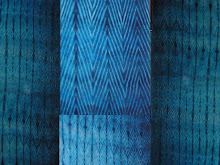"Shibori is the Japanese word for a variety of ways of embellishing textiles by shaping cloth and securing it before dyeing. The word comes from the very root shiboru, "to wring, squeeze, press." Although shibori is used to designate a particular group of resist-dyed textiles, the very root of the word emphasizes the action performed on cloth the process of manipulating fabric. Rather than treating cloth as a two-dimensional surface, with shibori it is given a three-dimensional form by folding, crumpling, stitching, plaiting, or plucking and twisting. Cloth shaped by these methods is secured in a number of ways, such as binding and knotting. It is the pliancy of a textile and its potential for creating a multitude of shape-resisted designs that the Japanese concept of shibori recognized and explores. The shibori family of techniques includes numerous resist processes practiced throughout the world."
From: SHIBORI: The Inventive Art of Japanese Shaped Resist Dyeing
Wada, Rice, Barton; Kodansha, 1983.
About Me

- Marcia
- From the beginning I loved textiles. As a child my mother dressed me in beautiful garments and as a young person Kismet was my favorite movie. The heroine danced in the bazaar flinging beautiful fabric.
Some of my mother's fashion handiwork.

How to Purchase
Because dye is difficult to control all orders are unique. If not already sold you may purchase the original. If already sold you can still purchase the "same" piece. Your order will be a new piece approximating the original as closely as possible (or with any differences you may request . . . perhaps you would prefer different colors). Clothing is available in S/M/L. Custom sizes are available. Money orders are preferred. Checks are acceptable and items will be shipped once they have cleared. Shipping and handling will be charged to the customer.
Please feel free to contact me with any questions.
veridical66@gmail.com
505.306.5279
Please feel free to contact me with any questions.
veridical66@gmail.com
505.306.5279
Winter Pond

!st Breakdown Print
Teaching Shibori

Class at Village Wools
Summer Dress Coat created by reversing the sleeves, folding excess fabric up and relining.

Sheer linen-like fabric. $350.
BDP 1

Beautiful Scarf/Wall Hanging
Subscribe to:
Post Comments (Atom)





































No comments:
Post a Comment